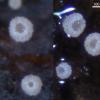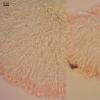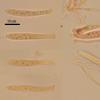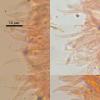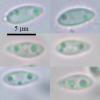
12-11-2025 09:25
 Viktorie Halasu
Viktorie Halasu
Hello, I need help with a pale terrestric Pseudom

11-11-2025 20:16
Bohan JiaHi, lastly I have found these tiny yellow decayin

09-11-2025 13:20
Hello.A tiny ascomycete, appearing as erupting gra

08-11-2025 00:29
 Francois Guay
Francois Guay
I found this species in Quebec, Canada, on herbace
Collected from bark of Pinus sylvestris, 09.09.2012, N60,893086° E68,677082°.
Apothecia cupulate, short-stipitate, whitish, disc smooth, outer surface and edge appear powdery from short hairs, near 200 x 150 mk.
Excipulum textura prismatica, cells about 10 x 7 mk in mid-length of excipulum, becoming near cylindrical in stipe; hairs uncinate, with attenuated slightly curved tips, about 20 x 2,5 mk; asci cylindrical, clamped, about 30 x 5 mk, with amyloid pore; spores elliptical to obovate, with two round guttules, 5,8 (4,9-7,3) x 2,4 (2-2,7); paraphyses the same length as asci, cylindrical, with 1-2 septa at base, 2 mk broad, occasionally encrusted.

Hamatocanthoscypha ocellata, SH 192-1.JPG
Are you sure you had the spores in KOH? They look as if alive!
Zotto
No, nothing alive under 1 m deep snow). So, used KOH to rewet them, but guttules still saved, inspite Stip writes "KOH scatters the guttules" (probably since solution is weak).

probably i misunderstand, what do you mean by living? They will grow, if there are suitable conditions, e.g. they are dormant (I did not kill them with some chemicals or at flame). But apothecia were collected in september, and were dried. Now i rehydrated them. I am trying to use water for mounts at first, but when tissues are still cohered i add KOH. The solution was prepared in 10% concentration, but later i added more water, so it is some weaker.?

To examine collections from summer and autumn during the winter months is convenient, I understand very well. But it is very disadvantageous. I regret I still do not have my powerpoint about this online. In any case you will meet living spores in your herbarium specimens. Usually asci etc. do not survive drying for so long, but in all those species that grow on exposed substrate such as attached branches etc. you can study fully alive apothecia even after 1/2 year or more. Only such species are dormant as a whole. The others have only dormant spores but these survive very different periods of time in the dormant state, between a few days up to several years, irrespective of whether they are hyaline or brown, thin- or thick-walled.
When you rehydrate dry living spores they gain their original shape within a few seconds. Of course, germination would take longer, some hours or so.
Zotto

To examine collections from summer and autumn during the winter months is convenient, I understand very well. But it is very disadvantageous. I regret I still do not have my powerpoint about this online. In any case you will meet living spores in your herbarium specimens. Usually asci etc. do not survive drying for so long, but in all those species that grow on exposed substrate such as attached branches etc. you can study fully alive apothecia even after 1/2 year or more. Only such species are dormant as a whole. The others have only dormant spores but these survive very different periods of time in the dormant state, between a few days up to several years, irrespective of whether they are hyaline or brown, thin- or thick-walled.
When you rehydrate dry living spores they gain their original shape within a few seconds. Of course, germination would take longer, some hours or so.
Zotto
so as these specimens were stored only 3 months they could be alive the whole, and spores as well. Alive microscopy - i am willing to follow this rule in next season).

